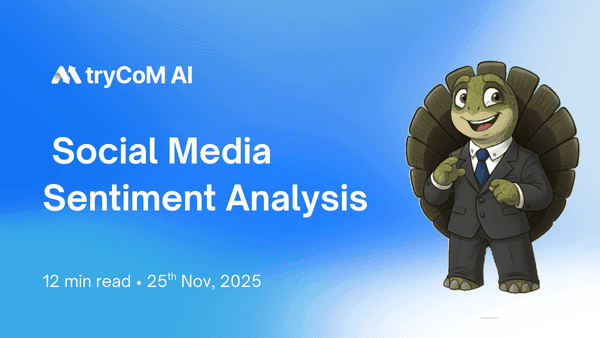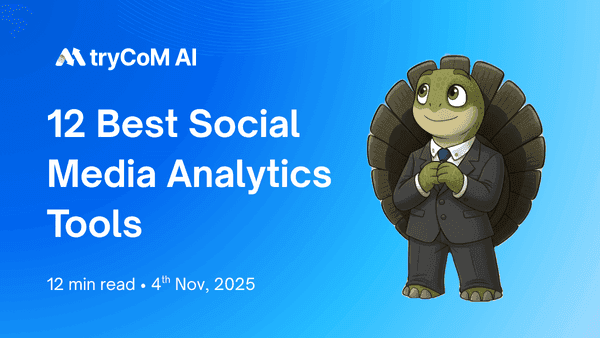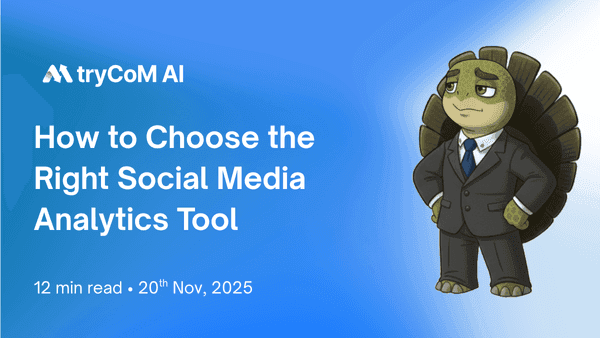Hashtag Analytics: The Complete Guide for 2025
Hashtag analytics is essential for understanding which hashtags truly boost your reach, engagement, and visibility across social media platforms. This guide breaks down the algorithms, metrics, and optimization techniques you need in 2025. Learn how to analyze performance and build a powerful, data-driven hashtag strategy.

Quick Summary
- Hashtag analytics helps track which hashtags drive reach, engagement, and visibility across social platforms like Instagram, TikTok, LinkedIn, and Twitter.
- Algorithms prefer relevant, niche, and contextual hashtags rather than broad or repeated sets; relevance is now more important than volume.
- Key metrics include impressions from hashtags, engagement rate, sentiment, and competitor hashtag usage, giving a 360° view of performance.
- A balanced mix of high-, medium-, and low-volume hashtags improves ranking potential and discoverability.
- Hashtag analysis should be done monthly, identifying top performers, replacing low performers, and refreshing rotating hashtag sets.
- Competitor hashtag analysis reveals industry trends and gaps, helping you find opportunities your competitors miss.
- A/B testing, seasonal hashtags , and AI-powered discovery tools significantly improve hashtag optimization and content performance.
Introduction
Hashtags remain one of the most powerful tools for improving content visibility across social platforms. But in 2025, simply adding hashtags is not enough — you must measure their performance. This is where hashtag analytics becomes a game-changer.
This in-depth guide covers everything you need — how hashtag algorithms work, which metrics matter, how to analyze performance, mistakes to avoid, and advanced optimization strategies.
What Are Hashtags and Why They Still Matter in 2025
Hashtags categorize content, help algorithms understand post context, and connect your content to broader communities, topics, and trends. Despite many algorithm changes, hashtags continue to influence:
- Discoverability
- Topical relevance
- Social search visibility
- Trend participation
- Community engagement
What Is Hashtag Analytics?

Hashtag analytics refers to the process of tracking, evaluating, and optimizing hashtags to understand how they contribute to your content’s performance. It answers questions like:
- Which hashtags drive the most reach?
- Which hashtags grow engagement?
- Which hashtags are increasing brand visibility?
Why Hashtag Analytics Matters for Social Media Success
Brands that analyze hashtags see 20–80% increases in organic reach, better engagement, and more accurate content targeting.
Improving Discoverability & Reach
Hashtags help surface your content to new audiences. Strong performing hashtags often contribute the majority of impressions on Instagram and TikTok.
Understanding Audience Behavior
Analytics reveals what topics your audience responds to and which they ignore, shaping your future content strategy.
Enhancing Engagement Metrics
Hashtags can directly influence likes, comments, shares, and saves by placing content where interested users search or browse.
Tracking Trends & Conversations
Monitoring trending hashtags helps you join conversations at the right moment.
Supporting Competitive Benchmarking
Understanding competitor hashtag strategy uncovers opportunities and patterns your brand can leverage.
Improving Campaign ROI & Content Strategy
With hashtag analytics, you can build predictable, data-driven content systems instead of guessing what works.
How Hashtag Algorithms Work Across Social Platforms
Algorithms differ by platform, but the core principle stays the same: context + engagement = visibility.
Instagram Hashtag Algorithm Mechanics
- Matches content with users based on interests and prior interactions
- Prefers relevant and niche hashtags rather than broad ones
- Penalizes irrelevant or overly repetitive hashtag sets
LinkedIn Hashtag Relevance & Topic Ranking
- LinkedIn categorizes content by “topic clusters”
- Niche professional hashtags rank better than generic ones
- Overusing hashtags decreases professional credibility
TikTok Interest Graph & Discovery Hashtags
- TikTok relies on an “interest graph,” not social connections
- Hashtags help categorize videos for the For You Page (FYP)
- Trending hashtags can give short-term boosts
X (Twitter) Trending Hashtags System
- Real-time data
- Popularity + velocity = trending
- Hashtags are crucial for news, events, and fast-moving topics
YouTube Tags vs Hashtags — What Matters More
- Tags help with backend SEO
- Hashtags help categorize content for search & Shorts
- Using 3–5 relevant hashtags is ideal
Facebook Hashtag Discovery Limitations
- Facebook’s adoption remains low
- Hashtags help with internal search but not with viral reach

Key Hashtag Analytics Metrics to Track
Below is a consolidated table of essential hashtag metrics:
| Metric Type | Examples | Why It Matters |
|---|---|---|
| Engagement | Likes, comments, shares | Shows content resonance |
| Reach & Visibility | Impressions, reach | Measures hashtag discoverability |
| Content Performance | Top posts per hashtag | Identifies patterns that work |
| Sentiment | Positive/negative mentions | Useful for brand reputation |
| Competitive Metrics | Share of voice | Shows where you stand in the industry |
Types of Hashtags and How to Analyze Them
Branded Hashtags
Your company or campaign name (e.g., #JustDoIt)
Analyze:
- Usage volume
- UGC growth
- Sentiment
Campaign Hashtags
Short-term marketing hashtags (e.g., #DiwaliSale2025)
Analyze:
- Campaign participation
- UGC creation
- Engagement spikes
Community Hashtags
Used by niche groups (e.g., #WomenInTech)
Analyze:
- Engagement relevance
- Competitor usage
- Community sentiment
Trending Hashtags
Short-lived but high-visibility hashtags
Analyze:
- Timing
- Velocity
- Relevance match
Geo-Specific Hashtags
Useful for local businesses or events (#ChennaiFoodies)
Analyze:
- Regional audience growth
- Check-ins and mentions
Niche Hashtags
Low-volume but high-intent hashtags (#MinimalistLifestyle)
Analyze:
- High engagement despite low volume
- Good for ranking on smaller hashtag pages

How to Conduct Hashtag Performance Analysis (Step-by-Step)
Step 1 — Define Your Hashtag Goals Your goal decides your hashtags. Examples:
- Boost reach → Use trending + niche mix
- Boost engagement → Use community-based hashtags
- Brand building → Push branded hashtags
Step 2 — Collect Hashtag Data
You can use tools or manual tracking. Both work depending on scale.
Step 3 — Evaluate Reach & Engagement
Look for hashtags contributing most impressions.
Step 4 — Identify High vs Low-Performing Hashtags
High vs Low Performance Indicators
| High-Performing Hashtag | Low-Performing Hashtag |
|---|---|
| Generates 20–40% of total reach | No noticeable impressions |
| Appears in “Top Posts” | Appears only briefly or not at all |
| Higher engagement rate | Low or zero engagement |
Step 5 — Compare Branded vs Non-Branded Hashtags
Branded hashtags drive loyalty; non-branded drive discovery.
Step 6 — Benchmark Against Competitors
Study:
- Their top hashtags
- Their engagement patterns
- Gaps you can exploit
Step 7 — Optimize Hashtag Groups & Sets
Create rotating sets of 3 types:
- High volume
- Medium volume
- Low competition niche
Step 8 — Test, Refine & Report Over Time
Hashtag performance changes often. Review every 30 days.
Choosing the Right Hashtags for Maximum Reach
Relevancy & Intent Matching
The most important factor for hashtag performance is relevance. Using unrelated hashtags may harm reach.
Balancing High, Medium & Low Competition Hashtags
Using only high-volume hashtags makes it harder to rank. Below is the ideal mix:
Hashtag Volume Strategy
| Category | Volume | Purpose |
|---|---|---|
| High competition | 1M+ uses | Visibility bursts |
| Medium | 100k–1M | Balanced growth |
| Low competition | <100k | Easy ranking |
Using Community-Driven Hashtags
Community hashtags bring the most engaged audiences. These users actively search for related content, increasing the chance of meaningful interactions.

Competitor Hashtag Analysis
How to Identify Competitor Hashtags: Scan your competitors’ top-performing posts to identify their most frequently used hashtags.
Measuring Competitor Hashtag Performance: Compare engagement metrics, post visibility, and ranking patterns. This helps you understand how effectively they use hashtags.
Finding Hashtag Gaps & Opportunities: Often, competitors miss niche hashtags that audiences actively use. Filling these gaps can help you capture untapped visibility.
Common Mistakes in Hashtag Usage & Analytics
Many creators and brands unknowingly limit their reach by misusing hashtags. One of the most common mistakes is relying on irrelevant or overly generic hashtags that fail to match the content’s intent, causing algorithms to deprioritize the post. Another frequent issue is reusing the same hashtag set repeatedly, which signals spam-like behavior and reduces discoverability over time. Some users also chase trending hashtags without checking whether they relate to their content, resulting in low engagement and poor audience retention. Finally, many rely solely on reach as a performance metric without analyzing engagement or sentiment, leading to misleading conclusions about what’s actually working. Avoiding these mistakes can significantly improve both visibility and audience interaction.
Proven Hashtag Optimization Strategies for 2025
- Use a mixed-volume set: Combine high-, medium-, and low-competition hashtags for balanced visibility and ranking potential.
- Rotate 4–6 hashtag sets: Prevent algorithm fatigue by avoiding repeated posting patterns.
- Prioritize niche and contextual hashtags: These hashtags attract highly relevant audiences and often outperform broad hashtags in engagement.
- Run A/B tests regularly: Compare different hashtag sets on similar content to identify consistent top performers.
- Monitor trends in real-time: Participate in relevant seasonal, cultural, or industry-specific hashtag trends.
- Leverage AI-powered hashtag discovery tools: Use AI to identify emerging hashtags and context-specific recommendations.
- Refresh hashtags monthly: Update or replace underperforming hashtags based on analytics insights.
- Use platform-specific counts: Adjust the number of hashtags depending on whether it’s Instagram, LinkedIn, TikTok, X/Twitter, or YouTube.

Conclusion
Hashtag analytics is no longer optional—it’s a crucial part of any modern social media strategy. By understanding which hashtags genuinely contribute to reach, engagement, and brand visibility, you can make smarter content decisions and grow consistently. Whether you’re a brand, small business, or creator, analyzing hashtags gives you clarity on what your audience prefers and how algorithms interpret your posts. When paired with a structured optimization approach, hashtags transform from simple tags into powerful tools that fuel long-term, organic growth. With continuous monitoring, experimentation, and refinement, your hashtag strategy becomes a reliable engine for sustained success across platforms.
Frequently Asked Questions (FAQs)
1. What is hashtag analytics and why is it important?
Hashtag analytics helps you understand which hashtags drive the most visibility and engagement. It ensures you’re using hashtags that align with your goals and attract the right audience, instead of relying on guesswork.
2. How many hashtags should I use on Instagram or TikTok?
Instagram performs best with 15–25 hashtags, while TikTok works well with 3–7 hashtags. Quality matters more than quantity — use hashtags that match your content and audience intent.
3. How often should I analyze and update my hashtags?
A monthly review is ideal. Hashtag performance fluctuates based on trends, algorithm updates, and user behavior, so refreshing your sets regularly keeps your strategy effective.
4. Why aren’t my hashtags giving reach anymore?
You may be using irrelevant, overly competitive, or repetitive hashtags. Algorithms prefer fresh, contextual hashtags. Updating your sets regularly can revive reach.
5. What type of hashtags work best — broad or niche?
Niche hashtags usually perform better for engagement because they attract a more targeted, interested audience. Broad hashtags offer reach but are harder to rank in due to high competition.
6. Should I use trending hashtags for quick visibility?
Trending hashtags can give a temporary boost if they’re relevant to your content. Using them without context lowers engagement and may reduce overall reach.

Annamalai Kathir (AK)
Annamalai Kathir (https://www.linkedin.com/in/annamalai-kathirkamanathan/) - Marketing Analytics & AI MarTech Expert. As tryCoM's CEO, he has dedicated his career to building AI tools that simplify marketing and performance optimization for startups, enterprise, and agencies. With 10+ years of expertise in SaaS product marketing, digital marketing, social media analytics, SEO/GEO optimization, and competitive intelligence, Annamalai leads the team in developing AI-powered marketing software that delivers social media listening, content automation, competitor analysis, and unified ROI measurement to help businesses and agencies achieve data-driven growth and measurable outcomes. Connect: https://akathir.github.io/ | https://www.instagram.com/akathirk/ | https://x.com/kathirannamalai
View profile →More blogs by Annamalai Kathir (AK)

Ultimate Guide for Social Media Sentiment Analysis 2025
Social media sentiment analysis helps brands understand the emotions, perceptions, and reactions behind online conversations. This guide breaks down how sentiment analysis works, why it matters, the metrics involved, and how it strengthens brand strategy. Perfect for marketers, startups, agencies, and businesses looking to use emotional intelligence to drive smarter decisions in 2025.

12 Best Social Media Analytics Tools Every Marketer Needs in 2025
Discover the 12 best social media analytics tools for 2025 that help marketers track performance, measure ROI, and gain deep audience insights. Learn how tryCoM unifies Google and social analytics for smarter, data-driven decisions.

How to Choose the Right Social Media Analytics Tool for Your Business in 2025
Choosing the right social media analytics tool can significantly impact how businesses measure performance, understand their audience, and optimize content strategy. This blog explains what social analytics tools are, the features that matter, how to evaluate them, and why tryCoM stands out as a complete all-in-one solution for social, SEO, website, and ads analytics. Whether you're a brand, marketer, or agency, this guide will help you make a confident, data-driven decision.